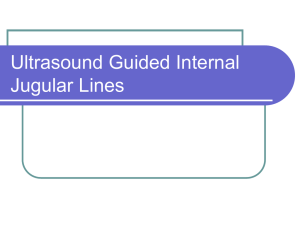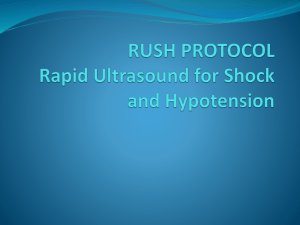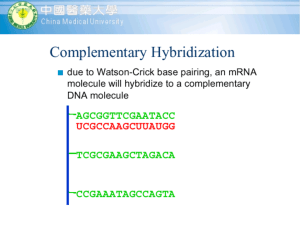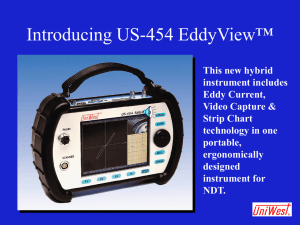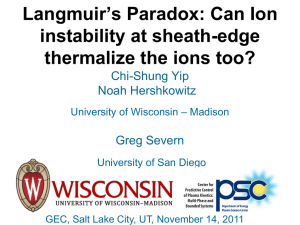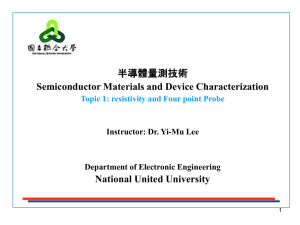PPT
advertisement
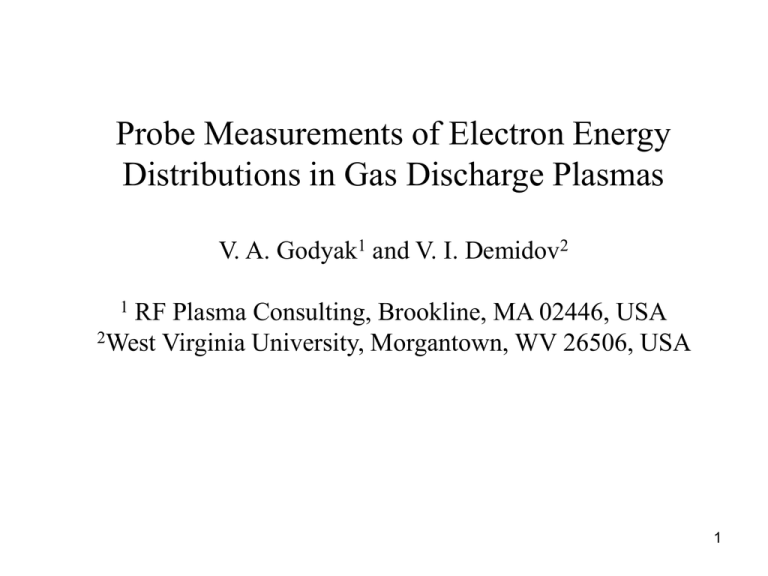
Probe Measurements of Electron Energy Distributions in Gas Discharge Plasmas V. A. Godyak1 and V. I. Demidov2 1 RF Plasma Consulting, Brookline, MA 02446, USA 2West Virginia University, Morgantown, WV 26506, USA 1 Electron Distribution Function f , Two-term approximation (small anisotropy, f1 << f0) Electron Energy Distribution (EEDF) and Electron Energy Probability (EEPF) Functions F(t,r ε) = 4 . 3 Langmuir formula and Druyvesteyn method Ie 2eS p m 2 ( eV ) f ( )d 2 eV eS p ( eV ) 2m eV F ( ) d eS p 2 ( eV ) f 2m p ( )d . eV Similarly, all plasma parameters (Tesk, λD, JB) and rates of plasmachemical processes (νea, νee, ν*, νi, ….) can be found as appropriate integrals of the measured EEPF. 4 What makes a good EEDF measurement? • We want to have more than Langmuir method gives us • EEDF has to resolve tail electrons (ε>ε*) responsible for excitation, ionization and electron escape, as well as low energy electrons (ε< Te) accounting the majority of electrons • Due to error augmentation inherent to differentiation procedure, small (invisible) inaccuracy in Ip(V) can bring enormous distortion in the measured EEDF • It is important to realize the source of the possible errors and to be able to mitigate them. • The sources of the errors are well elucidated in the literature, but are insistently ignored in the majority of published papers. 5 Problems in probe measurements and their mitigations. 1. Probe size: a[ln(πl/4a)], b, λD << le and Ip << Id, Ir, Iz Ir = IB = ScheNsvB, vB = (Te/M)1/2,,,,,.. Iz = eΓe is the current corresponding to generation rate of electrons with energy ε in the volume defined by the chamber characteristic size Λ, or by the electron relaxation length λε, To neglect the voltage drop across the wall sheath, the following requirement has to be satisfied: (SpN0/SchNs)(M/2πm)1/2 << 1 a = 38 μm b = 175 μm 6 Probe constructions P1 P2 a = 0.05 mm, b = 1 mm, c = 2-3 mm 7 Probe circuit resistance (the most frequent problem) 8 EEPF Druyvesteynization due to Rc δ = Rc/Rpmin Rpmin= Te/eIesat Error in EEPF less than 3% requires Rc/Rpmin < 0.01 ! 9 Example of EEPF measurement in argon ICP with a low disturbance probe having Rc and noise compensation 13 Maximal argon pressure, where measurement was possible, was limited by the chamber surface 50 , 10 12 10 11 10 10 9 10 8 10 7 300 mT 100 * i 10 50 13 6.78 MHz, 50 W 50W 8 -3 plasma density (cm ) 10 -3/2 10 10 50W -3 eepf (eV cm ) 6.78 MHz, 50 W 10 1 0.3 .3mT50W 10 12 10 11 10 10 6 4 2 6 0 10 20 30 electron energy (eV) 40 50 10 -1 0 1 10 10 10 gas pressure (mT) 2 0 3 10 10 effective electron temperature (eV) 10 Argon, 20 mTorr VGPS: max = 15-22 eV Comparison of EEPF measured with different commercial probe stations At maximal discharge power of 2 kW, N ≈ 1·1012 cm-3, thus EEPF has to be Maxwellian νee ∞ NTe-3/2 Maxwellization Argon, 20 mTorr Espion: max = 7-11 eV “Druyvesteynization”” Distorted @ low energy and lost information @ high energy 11 In a high density plasmas, EEPF at low energy must be Maxwellian 12 RF plasma potential Criterion for undistorted by rf sheath voltage EEPF measurement is known for over 30 years (1979) Zpr/Zf ≤ (0.3-0.5)Te/eVplrf A presence of a filter in the probe circuit does not guarantee undistorted EEPF measurement. To do the job, the filter has to satisfy the following condition for all relevant harmonics: Zf ≥ (2-3)ZpreVplrf /Te For filter design we need to know (measure!) Vplrf and minimize Zpr 13 Filter design procedure Zpr is defined by its sheath capacitance at floating potential 14 Probe measurement circuit incorporating, dc voltage and low frequency noise suppression, rf compensation and rf filter dc resistance compensation with I/V converter having a negative input resistance 15 Example of EEPF measurement demonstrating a paradoxical Te distribution in argon 13.56 MHz CCP 30 mTorr, Teo < Tes 300 mTorr, Teo > Tes 16 EEPF and plasma parameters evolution during CCP transition to the γ- mode 17 Time resolved EEPF measurements EEPF measured in afterglow stage of ICP with internal ferrite core inductor 10 12 Ar, 30 mT, 50 W; off cycle Ar, CW 100 W 10 11 10 10 off = 2 s p Te (mT) (eV) = 20 s 1 eepf (ev -3/2 -3 cm ) T on 10 t = 2.8 s 3.6 4.4 6.8 9.2 12.4 18.8 9 0 5 10 electron energy (eV) 3.0 10 30 100 300 electrron temperature (eV) T 6.5 4.2 3.1 2.1 1.5 300 0.1 100 30 3 mT 10 15 1 10 100 time (s) 1000 18 EEPF and Te measured along rf period in an induction lamp operated at 300 mTorr Ar and 7 mTorr Hg Time resolution δt = 0.5 μS. Note asymmetry in Te(ωt) 80 1010 5 S 109 t = 1 S 108 0 1 2 3 4 5 energy (eV) 6 7 8 2 60 8 1 2A 40 4 0.5 8 20 0 0 0 5 10 15 20 time (S) Probe sheath capacitance to plasma is the main limiting factor in EEPF measurement speed. The minimal time resolution, δt > (10-30)ωpi 19 electron temperature (eV) lamp voltage (abs. value V) eepf (eV -3 / 2 -3 cm ) 10 50 kHz 50 kHz, 2 A 11 1.5 Ion current effect Ip = Ie + Ii and I”p = Ie”+ Ii” Ion current effect occurs in light gases, low density plasmas and small probes, and is maximal at orbital ion motion (a/λD < 1), according to: Ie”/Ii” = (4πM/m)1/2η3/2exp(-η) η = eV/Te independently on a/λD In practice, Ii” effect is essentially smaller and can be neglected Ratio Ie”/Ii” depends on EEPF and a/λD 20 Relative Ii” effect for orbital and radial ion motion for Maxwellian and Druyvesteyn distributions Ie”, Ii”, Ip” Orbital motion Radial motion Hydrogen a/λ D 1.0 10 100 eV/kTe 21 Accounting for Ii” contribution In many works and commercial probe instruments, the extrapolated from large negative probe potential Ii(V) is subtracted from Ip(V) with following differentiation. Due to uncertainty of the extrapolation and error augmentation caused by differentiation this way of accounting for Ii” brings more error than correction. Ion probe theories used in probe diagnostics do not account for: • Non-Maxwellian EEDF • Rear collisions that destroy OM • Two-dimentionality of the probe sheath • Ambipolar ion drift (Va >> VTe) • Plasma parameters found from Ii(V) may be up to an order of magnitude differ from those found from Ie(V)! 22 Probe surface effects I”p(V) Φwf (Volt) Ne + 5% benzyl Ar Mo Ta W 23 Probe surface effects: • Probe surface work function (changes during probe scan) • Non conductive layer of reaction product → (Rc) • Sputtering of electrode and probe and deposition conductive layer on the probe holder → Sp • Strong temperature dependence of all above REMEDIES • Continuous probe cleaning with fast probe scan (mS) • Ion bombardment, electron heating and rf biasing • Probe cleaning before or after probe scan is ineffective 24 EEPF measurements with VGPS in Plasma reactors (Wide specter and large amplitude of rf plasma potential and high rate of probe contamination are the major problems) Microcrystalline silicon deposition Ar/SiF4 10 mTorr ECR. Ecole Polytechnique H2/CF4 30 mTorr ICP with polymer deposition. University of Maryland 25 A remark Today, plasma simulation codes are practically main tool for study plasma electrodynamics, plasma transport and plasma kinetics in commercial plasma reactors. These codes applied to complicated processing gas mixture are missing many cross sections for variety of (accounted and not) plasma-chemical reactions. They also are missing effects of nonlocal and nonlinear plasma electrodynamics that has been proved can be important and even dominant in rf plasmas at low gas pressure. In such situation, a feasibility of EEDF measurement in plasma chemical reactors would give a valuable experimental data for understanding variety of kinetic process in such plasmas and validation of existing numerical codes. 26



